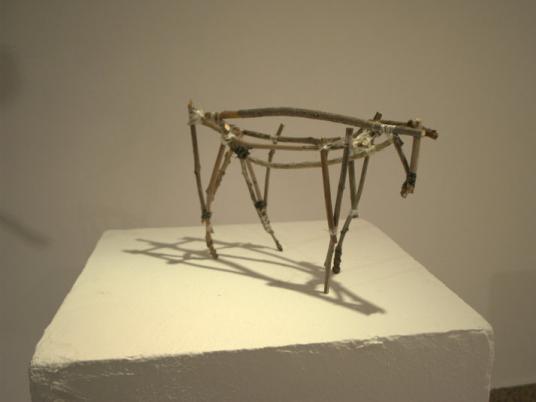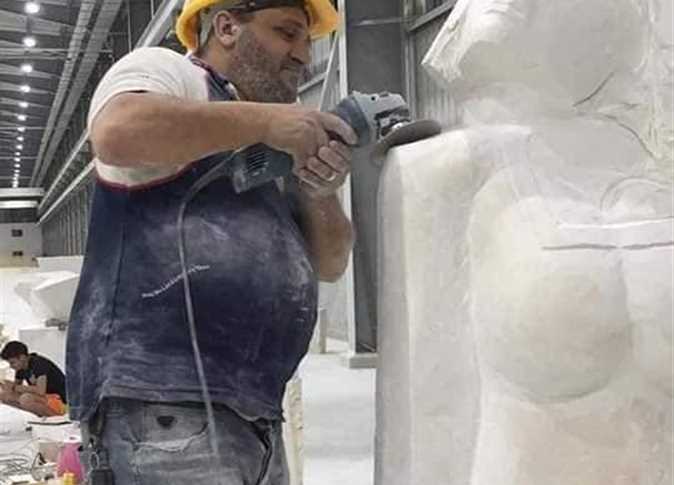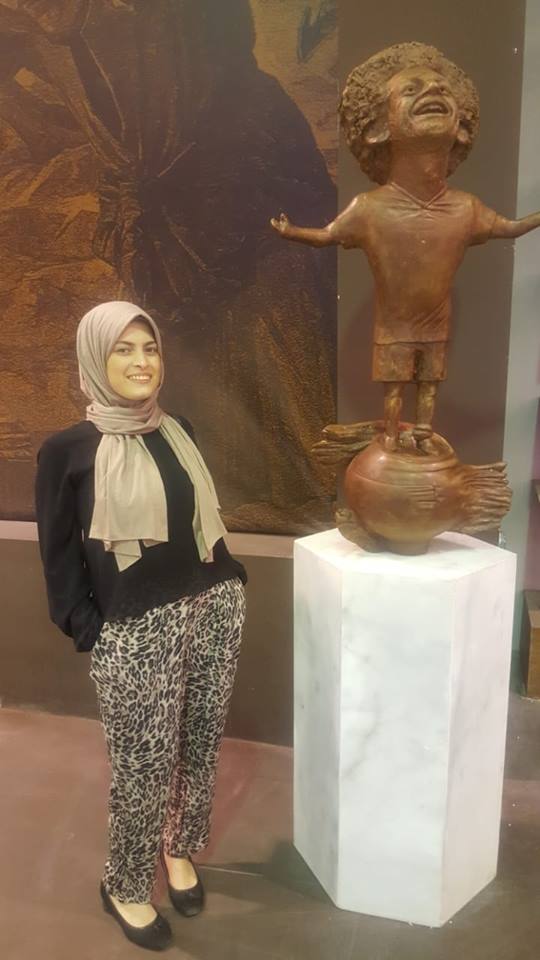
When Alaa Abd al-Hamid held his exhibition, "The Situation is Fluid," at Artellewa almost a year ago, the young sculptor was preoccupied with the slow encroachment of religious extremism, and wrapped his whimsical metal sculptures in symbolism, depicting conservative Islam as the weight that keeps down a society otherwise ready to float unencumbered toward something better.
But the most intriguing thing about Abd al-Hamid’s work was simply the sculptures themselves, and not the symbolism he attached to them. This past year in Egypt, nothing has happened that would assuage anyone’s concerns over political Islam, but as Abd al-Hamid embarked on a residency in rural Spain, as part of an exchange with Artellewa, he left behind the somewhat didactic conceptual structure imposed on his previous exhibition, and delved into an exploration of the expressive potentials of the rough-hewn, found materials he uses for his constructions.
Abd al-Hamid’s new work, “When I Was There,” most of which he created while on residency in Spain, is on exhibition at the Saad Zaghloul Cultural Center, as part of a small collection of simultaneously held solo shows of young artists, including Mohammed al-Deib, Heba Saleh, and Maged Mikhail.
With this new work Abd al-Hamid has traded in rusted metal canisters and pipes for sticks, twine and glue, and has emerged with a wider variety of forms that are poetic and expressive, and show great sensitivity to the specific nature of the material being used.
Abd al-Hamid leads a dual existence as an artist, splitting his creative energies between constructing sculptures and writing fiction. At 25, he has already written two novels, the second of which, “Security,” was published by Dar Merrit earlier this spring. He says that his two creative outlets complement each other, filling in the gaps of expression in both forms, one a space for articulation, and the other for a more abstract, emotional reaction.
In introducing his works with a text written while he was still on residency, Abd al-Hamid describes the dream-like disconnection he experienced in the small town of Farrera, nestled in the mountains in Northern Spain.
“I put the name of this project ‘When I Was There,’” he writes, “when I am still in Farrera, as if I’m talking about another experience in a different place and from a long time ago.”
This sense of quiet, hermetic separation from the world is present in the mostly small sculptures he has constructed, which maintain in their forms the experience of their assembly.
He primarily works with something reminiscent of a human figure, but the specific form arises out of the materials he collects, whether they are twigs, rusted metal, or the disposable plastic tubes of a shisha pipe (a material Abd al-Hamid has been experimenting with recently). Although he does not create objects that take his environment as a subject, what he creates holds the imprint of his environment.
When Abd al-Hamid arrived in Farrera, his drastically changed surroundings demanded working with a new kind of material. “Iron is strong, and feels connected to the crowds and chaos of Cairo,” he says, “But this soft material comes from Farrera.”
The most exciting sculpture in “When I Was There,” however, is the only work Abd al-Hamid created in Cairo, and it reflects the dissonance between material and location he experienced while creating it in his studio in Ard al-Lewa.
It is the largest sculpture in the collection (partly because the work Abd al-Hamid created in Spain needed to be small enough to be transported back to Cairo), and carries the most formal variety. Roughly constructed, standing as a kind of amalgamation of human, animal and plant, the work changes in shape and mood when viewed from various directions. From one angle, the figure, composed of thick sticks roughly wrapped together with twine and glue, stands in nearly perfect contrapposto, a hint of the formal perfection of Greek statue, but when viewed from another side, sticks protruding from the top of the sculpture appear an indecipherable cross between deer antlers and human arms, flung out at wild angles.
“While I made [this sculpture], I felt I didn’t care about the material. I could destroy it, if I wanted to. But when I worked in Spain I felt I cared about this soft material,” says Abd al-Hamid.
This somewhat confrontational relationship is a visible and exciting tension within the piece. The structure appears almost angrily assembled, and it strikes a stark contrast in particular to such smaller, more gently assembled pieces as one of a donkey, in which tiny, delicate twigs, tied together exactly at the animal’s joints, curve in precisely the right way to come together as a static four-legged creature.
These works, like Abd al-Hamid’s previous work, maintain a strong sense of open experimentation with material. Without any imposition of symbolism, these elegant, intriguing, sometimes quiet and settled, sometimes rough and changeable, forms are a reflection of the artist’s emotional state, refreshing and rewarding to look at.
“When I Was There” will be on display at the Saad Zaghloul Cultural Center, 2 Saad Zaghloul Street, Sayeda Zeinab, Cairo, until 7 June, along with the exhibitions “The Black Box” by Saleh, “Colored Gypsum” by Mikhail, and “A Moment of Happiness in Different Ways” by Deib.




